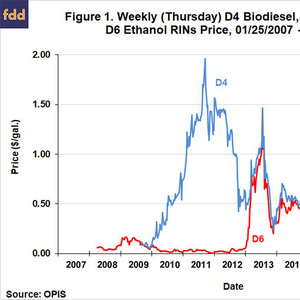Analysis: Lower RIN prices are coming without changes to the RFS

FarmDoc Daily
February 16, 2018
BY Renewable Fuels Association
A new analysis from the University of Illinois shows that the conditions that caused high conventional biofuel (D6) RIN prices are changing rapidly and that “…it is not out of the realm of possibility for D6 RINs prices to fall back their pre-2013 level of just a few cents without making any changes to the RFS.”
The authors argue that high D6 RIN prices have been driven by the “gap” that exists between domestic ethanol consumption (estimated at 14.5 billion gallons in 2017) and the 15-billion-gallon statutory requirement for conventional renewable fuels. The size of that “gap” continues to shrink rapidly as E10, E15, and E85 blending has expanded. Thus, as that expansion continues at a rapid pace, the “gap” will be fully closed and RIN prices will fall dramatically. As the Renewable Fuels Association has pointed out, this is exactly how the RFS was intended to work. Establishing RVP parity for E15 would certainly help accelerate the closing of that gap. Specific findings from the University of Illinois report include:
- “What seems to have gotten lost in all the noise surrounding the political war over the RFS is how rapidly the conditions are changing that created the high ethanol RINs prices in the first place. The key is the "gap" between the ethanol blend wall and the conventional ethanol mandate.”
Advertisement
Advertisement
- “With the statutory conventional ethanol mandate fixed at 15 billion gallons, the growth in ethanol use has led to a sharp decline in the magnitude of the conventional gap. In particular, the latest ethanol use estimate from the EIA for 2019 implies a conventional gap of a little less than 300 million gallons. This gap is so small that an increase in projected ethanol use for 2019 of just two percent would erase the gap completely.”
- The bottom-line from this analysis is that the conventional ethanol gap is well on its way to being eliminated in the next few years, even without a large expansion in the use of higher ethanol blends such as E15 and E85. If this does occur, the impact on D6 ethanol RINs prices could be almost as profound as what we witnessed in 2013, but in exactly the opposite direction.
- “It is not out of the realm of possibility for the price of D6 RINs to go back to their pre-2013 level of just a few cents. Of course, this assumes that the conditions that have been driving ethanol consumption upward do not change. Even if conditions do change, the size of the conventional gap is much more manageable than just a few years ago and opens the door for very modest increases in E15 and/or E85 to close the conventional gap. For example, a 300 million gallon conventional gap could be eliminated with an increase in E15 consumption of just 2 billion gallons, or about 1.3 percent of total gasoline consumption.”
Advertisement
Advertisement
- “This means it is not out of the realm of possibility for D6 RINs prices to fall back their pre-2013 level of just a few cents without making any changes to the RFS.”
“The first supposed ‘blend wall’ was the 10 percent ethanol blend level. Well, we crashed through that last year and are now blending above 10.0 percent nationally,” said Renewable Fuels Association President and CEO Bob Dinneen. “But the next blend wall is the 15-billion-gallon allotment for conventional ethanol. With increased E15 and E85 blending, we are careening toward smashing that wall as well. It seems, however, that the closer we come to that wall, the more intent some refiners become in hitting the brakes, insisting upon RFS demand destruction as the only safe course. This analysis lays waste to that false premise, and demonstrates, as we have insisted for years, that increased ethanol use will also break the 15-billion-gallon wall and lead to lower RIN prices. And RVP parity for E15 would lower RIN prices even more quickly while leaving the RFS intact. Now that’s a win-win,” he added.
Related Stories
The U.S. EPA on July 8 hosted virtual public hearing to gather input on the agency’s recently released proposed rule to set 2026 and 2027 RFS RVOs. Members of the biofuel industry were among those to offer testimony during the event.
The USDA’s Risk Management Agency is implementing multiple changes to the Camelina pilot insurance program for the 2026 and succeeding crop years. The changes will expand coverage options and provide greater flexibility for producers.
EcoCeres Inc. has signed a multi-year agreement to supply British Airways with sustainable aviation fuel (SAF). The fuel will be produced from 100% waste-based biomass feedstock, such as used cooking oil (UCO).
President Trump on July 4 signed the “One Big Beautiful Bill Act.” The legislation extends and updates the 45Z credit and revives a tax credit benefiting small biodiesel producers but repeals several other bioenergy-related tax incentives.
CARB on June 27 announced amendments to the state’s LCFS regulations will take effect beginning on July 1. The amended regulations were approved by the agency in November 2024, but implementation was delayed due to regulatory clarity issues.
Upcoming Events










